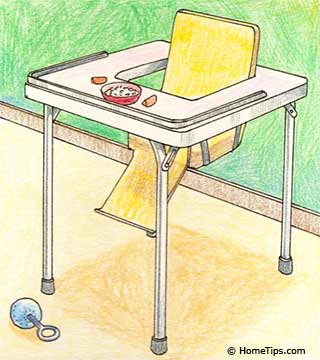Expert guide to buying safe high chairs, baby feeding tables, child booster seats, and hook-on chairs.
Depending on the layout of your house and your family’s customs, you may eat in a kitchen dining area or a formal dining room, at the same or a separate time from baby. Keep all cutlery, even spoons, away from a young child. Do not let baby get within reach of any breakable tableware. And never leave a small child who is eating unattended.

Child-size feeding table keeps baby happy, busy and safe.
From booster seats to feeding tables, a variety of dining furniture is available for today’s young child. By far the most popular choice—though not always the safest—is the high chair.
This guide will help you choose safe high chairs, baby feeding tables, and more.
Baby Feeding Tables
Feeding tables provide secure seating for both mealtime and play. Set close to floor level, they resemble walkers, except that most tables do not have wheels. From the time a child can sit up until about age 2, the feeding table offers all the advantages of a high chair with less risk of falling.
As with a high chair, place a feeding table away from dangerous areas and objects. Look for a feeding table tray that’s too wide for your child to reach across.
A feeding table should be stable and should fit your child comfortably. It should have a safety strap with a crotch strap to keep the little one from wriggling or sliding out; before buying, test it to see that you can fasten the strap easily.
If the feeding table is a fold-up design, make sure that its locking device holds securely in the open position.
Safe High Chairs Checklist
To a parent, the high chair is a wonderful convenience. It seats baby at an adult level yet restrains wriggling and mostly confines mess-making (still, it’s a good idea to place a nonskid dropcloth underneath it).
To the small child, however, a high chair can look like an indoor climbing gym. And the more active the tot, the more strain is put on the high chair’s safety straps, tray lock, and stability. Unfortunately, many kids, when standing, reaching, climbing, or just rocking, fall from high chairs or cause them to topple over.
To help prevent such accidents, choose high-quality equipment and use it properly. Look for these important features when shopping for safe high chairs:
- A reasonably safe high chair can hold 50 to 100 pounds. Check that all surfaces are free of sharp edges or protrusions, as well as hardware that could pinch or cut.
- Be sure the chair comes with a sturdy safety belt with a crotch strap that’s not attached to the tray and is easy to use, even when you’re in a hurry. Never count on the tray alone to be a safety restraint.
- Choose a high chair with a locking tray that your child can’t move or get off. Before buying, try it out to see how easily you can remove, replace, adjust, or lock the tray with one hand. A good design swings or slides out without detaching from the chair. The tray should also be unbreakable if dropped.
- The high chair’s base should be wide enough for good stability against tipping, even when your child rocks back and forth. The base should not be so wide, however, that you can trip over its legs.
- Make sure that a folding high chair locks securely when in use and that the tray is locked in place after you seat your child.
- Never allow your toddler to even attempt to climb the high chair. Keep the high chair away from any wall, furniture, counter, or other object that the little one could topple or push off against.
Safe Child Booster Seats
A popular dining chair accessory for toddlers, booster seats can be safely employed at home or at restaurants with proper usage.
Belt the booster seat to the chair; then strap your child to the booster seat. Your child should be at least 18 months old and able to sit up straight with good balance.
Use only a sturdy, flat-seated, straight-backed chair as a base.
Safe Hook-on Chairs
Also called hanging chairs, hook-on chairs attach to the edge of the dining table. They’re simple and portable, and they invite an older baby or young child to join the family at the table. Most will hold a child up to about 40 pounds.
The best-designed hook-on chair’s safety depends on how securely you attach it, as well as whether your table can support the chair and the child’s weight and remain stable.
Buy only a chair with a clamp that locks onto the table. Test the chair’s attachment by putting weight on it.
Check that caps or plugs on tubing are firmly fixed and cannot easily be pulled loose.
Make sure the chair has a safety belt—and that you use it. Also be sure there’s no other chair near enough that the seated child could topple or push off of.
TIP: For assurance of high standards, look for the JPMA “Certified” seal on all mealtime gear.
